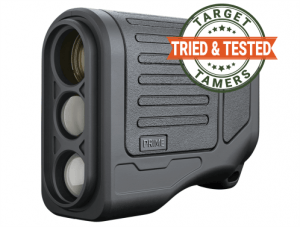
Model: Prime 1300 5x20
Distance Range: 5-1300 yards
Magnification: 5X 20mm objective lens
Measuring System: Yards/Meters
Angle Compensation: Yes
Waterproof: No
Use: Rifle Hunting, Bow Hunting, Target Shooting
Price Range: Under $200
"For a hunter who mostly pounds the timbers, the Prime 1300 rangefinder makes things incredibly easy. It's built for the woods, and I highly recommend it for close range hunting."
New! Bushnell Prime Rangefinder Hands On Review & Field Test
Bushnell has hit a triple home run with three new lines of sport optics that includes the Prime Series. Within the Prime line, Bushnell offers binoculars, rifle scopes, and rangefinders which ends up being a complete kit for a hunter on a budget.
As the third most expensive optic in the new series, we had to test out the grit of the Prime 1300 5x20 rangefinder (RF) to see if it adequately sets the stage for the rest of its Prime cohorts. We purchased a brand new model for our review. Here's how it fared out in the field.
What's in the Box?
The Prime rangefinder arrives dressed in an orange and grey box that matches all the new Prime series optics, and some of the Nitro too.
I like the consistent branding of packaging, and as expected, everything is bubble-wrapped and plastic bag protected during shipping.
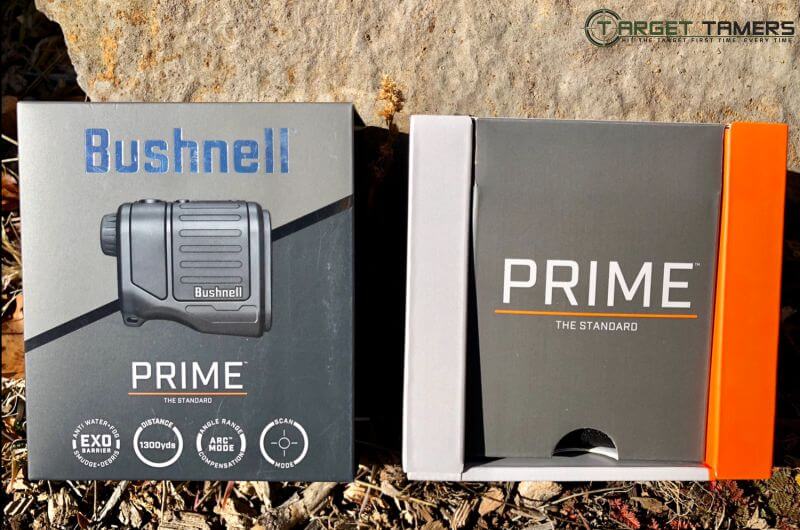
Nylon Case
Of course, the rangefinder is sitting in a small, black nylon case in its package. There's nothing fancy about it. It has a noisy Velcro flap attachment and a strap on the back for looping through a belt or a neck strap if you want.
I probably won't be using it except for keeping the rangefinder in it during storage.
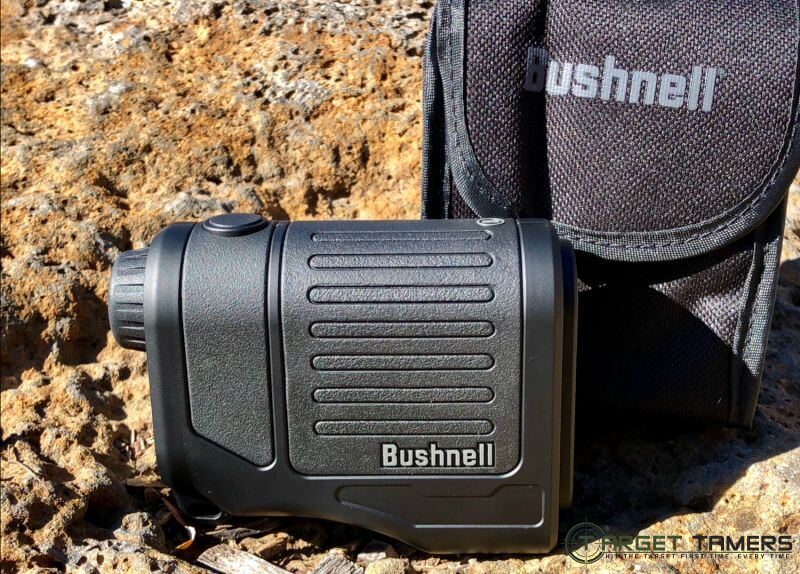
Lanyard (No) & Battery (Yes)
Sorry, there's no lanyard included. It's typically expected that a lanyard gets thrown in as an accessory with a rangefinder, but not with this one.
Although no lanyard is included, there is a connection loop built into the rangefinder on the underside of the battery compartment - and yes, at least a 3V CR2 battery is included.
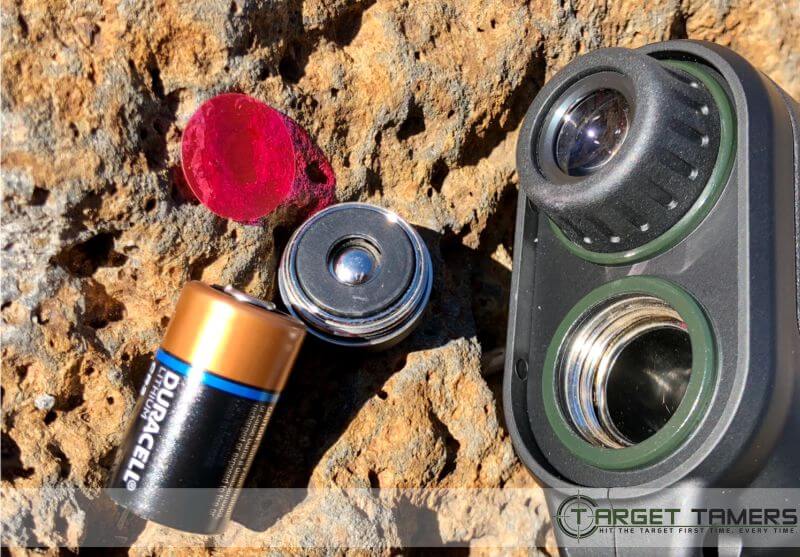
Paperwork
A three-step instruction card is very brief in providing setup directions. However, there is a sheet of paper that directs you to the Bushnell website to view the complete instruction manual online.
A small paper slip has two sentences in English providing general care and maintenance instructions. Among the paperwork is a small bag with a lens cloth.
Everything about the packaging to the paperwork is done with minimalist style for simplicity. Although the instructions are few, I found that's all it takes to get ranging right away.
So far, the branding and lack of complex sheets of paper is pleasing, and it's certainly setting a precedent of how I expect the rangefinder to perform.
The Prime 1300 Build
Let's look at the various features and design benefits of the Bushnell Prime 1300 to give you a sense of what it can offer you in the field.
Small Size
My first impressions matched my expectations. It's lightweight at only 5.8 oz. It fits comfortably in the hand with compact dimensions of 1.6 x 4.3 x 3.2 inches.
The Prime 1300 is made to be portable and easily stowed away. It went straight into the deep recesses of my coat pockets when I hit the trails.
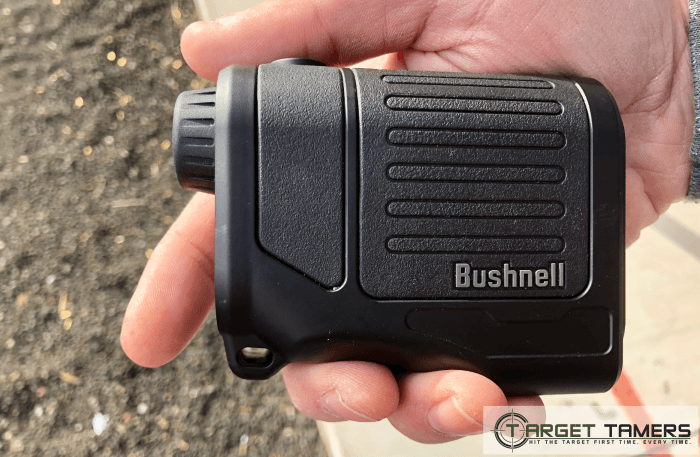
Exterior
Although it's less than half a pound, the RF has good weight to it as it doesn't feel flimsy or cheap at all. It feels like a solid RF that will hold up in the field, even if it isn't completely waterproof.
A very lightly textured rubber armor covers a good portion of the unit, and the eyepiece gets a nice, thick wrap of the stuff. However, I wish it extended to the underside of the unit as well.
The hard plastic will be prone to acquiring more than a few scratches over its lifetime. Mine donned a few within the first few seconds of box-opening as it took a tumble over some rocks (you can see them on the right of the rangefinder in the photo below).
Did it affect the internals and accuracy? Not one bit.
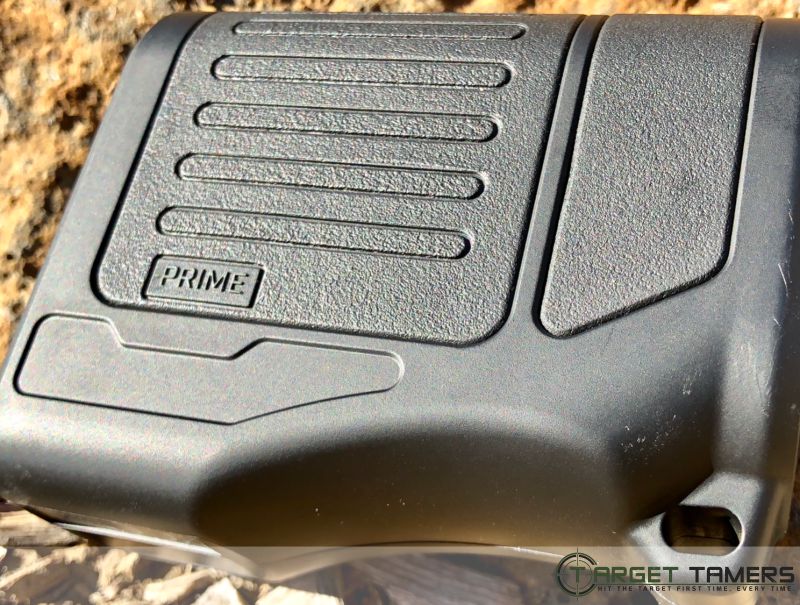
One-Button Operation
This RF is truly designed on the one-button operation method. There is no separate Mode or Power button as there is only one button that does it all. It makes things easy and that's exactly what you need in the field - simplicity and ease.
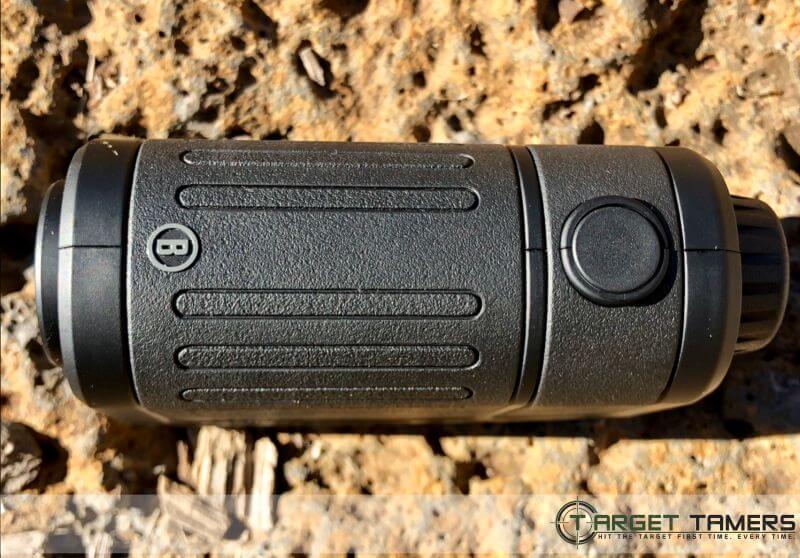
How do you get a Distance with the Prime Rangefinder?
To get a distance, you simply push the button once to turn it on, and if you have battery juice in it, it's instantly up and running. Push the button and hold it down to get a distance.
You will see four crosshairs blink around the reticle circle and this means it's acquiring the distance to the target. You can let go of the button once a distance is displayed and the crosshairs will disappear. It's that easy, and that's exactly how it worked for me when ranging rocks, ducks, and trees.
If you continue to hold down and move the unit from left to right, it'll kick into Scan mode. Once I figured all this out, which wasn't difficult by any means at all, I had to figure out if it could switch measuring from yards to meters without the use of a Mode or Menu button.

Does the Prime 1300 measure in Meters?
Once you know how to do it, it's an easy move to get the Prime 1300 to measure in meters. Admittedly, I had to look up the complete online instructions to figure it out.
With the unit completely off and with nothing in the display, you hold down the button until an "M" appears and starts flashing in the bottom right corner of the display. To go back to yards, repeat this process until the "Y" appears and starts flashing.
Scan Mode
Scan mode works very well and fast across the board. I had no issues there. In fact, it almost seemed faster to get a reading on an object using Scan mode than it did to get a single reading on an object the further away it was.
Angle Compensation
Can ARC Mode be turned on and off?
ARC mode is always on. There's no way to turn this feature off - well, not in any way I've found or that I've read in the instructions. The display instantly shows two distance readings.
The top number will be the line of sight distance and the number beneath it will be the true horizontal distance (angle compensated distance). The Prime will display an angle compensated distance for up to 99 yards.
What's convenient about the dual distance display reading is you don't have to switch between modes, fiddle with a settings menu, or use a Mode button to have to get in and out of ARC mode. It's on when you need it, and just ignore it when you don't.
External Coatings
As you can guess, the Prime 1300 also sports Bushnell's new EXO Barrier coatings. It's an anti-water, fog, and debris coating that will protect all those air-to-glass surfaces we know will get some exposure while out on the hunt.
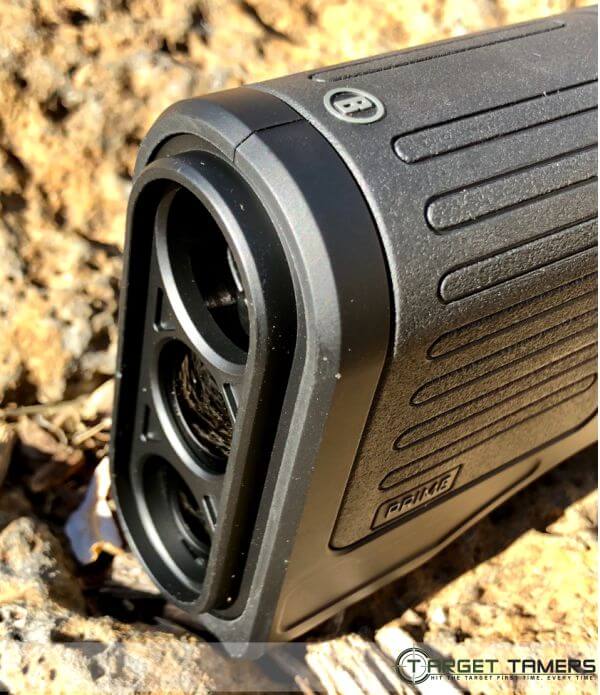
Prime 1300 VS Prime 800
Bushnell's Prime series of rangefinders is made up of just two units, the Prime 1300 (Model LP520KB) and the Prime 800 (Model LP623SBL). The 1300 has a maximum range of 1300 yards (reflective) and not surprisingly, the 800 has a maximum range of 800 yards (reflective).
They weigh the same and the size of the units is nearly identical. The most notable difference between the two is that the Prime 800 has 3 targeting modes. In addition to SCAN you have BullsEye™ Mode and Brush™ Mode. Compare the specs for the two below:
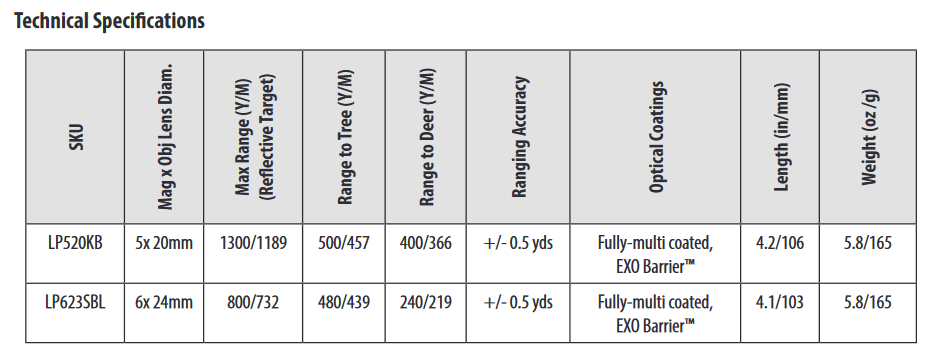
Field Test: Looking at Performance of the Prime 1300 Rangefinder
Out in the field, the Bushnell Prime range finder was everything I needed. I couldn't have asked for more since I don't see the need to over-complicate things.
The one-button operation is my favorite design benefit as I didn't have to think twice about pressing the right button and I didn't have to look at the unit for visual confirmation on using the right button either.
For as compact as the unit is for it to comfortably fit in my coat pockets, I liked that it felt a little "bulky" in the palm of my hand.
It has a solid build to it with enough meat to grab and securely hold for use in the field in wet conditions or when there's rivers of adrenaline running through your veins and you've got the slight shakes.
But, the first thing you will all figure out when you put the RF to your eyes is its long eye relief.
What is the Eye Relief on the Bushnell Prime?
The eye relief on the Prime 1300 is incredibly forgiving. I couldn't tell you how long it is exactly, but it must be around the 20-24 mm range. I even tried it with spectacles on, and with them sitting up on the nose, I had no problems.
Sunglasses work fine with the Prime RF too, however, polarized sunglasses showed aberrations through the optic.
Once I figured out where I was comfortable viewing through the eyepiece, I tried to see if I could adjust the diopter. With much twisting and gripping, it doesn't turn. There is no adjustable diopter, but the display is still more than satisfactorily sharp and black.
It's now time to start ranging some random targets.
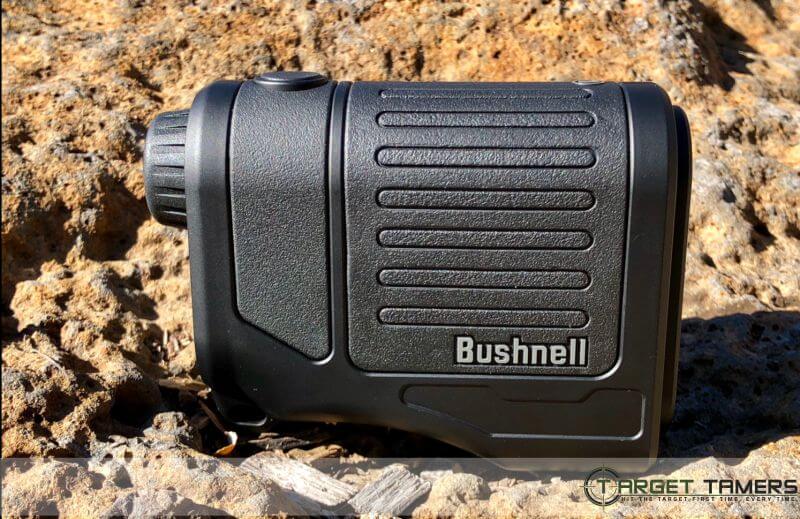
Rangefinder Test Day 1: Woods
Cool, cloudy weather
It was during this test that I found it was difficult to use a digiscope adapter with the Prime RF due to the long eye relief, so photo evidence is a no-go. In the woods, acquiring close range readings was a breeze. Target acquisition was fast and responsive since all my readings were under 250 yards.
The fact that angle compensated distances are automatically displayed was extremely convenient. I didn't have to fiddle around between making sure I was in the right mode. The display wasn't too shaky or presented many issues since most of my targets within 250 yards fit comfortably within the reticle aiming circle.
For a hunter who mostly pounds the timbers, the Prime 1300 rangefinder makes things incredibly easy. It's built for the woods, and I highly recommend it for close range hunting.
Rangefinder Test Day 2: Open fields
Cold, snow, cloudy weather
I wasn't expecting snow to come on so soon, but nevertheless, it gave me a great opportunity to test out the rangefinder's mad skills in some of the worst weather possible. I wanted to take things a step further than the first test day, and what better way to do that than with light-scattering, glistening snow? I know, harsh right?
First off, due to the compact and lightweight design, the Prime was more susceptible to shakiness when trying to range for longer distances. I had to steady my hand or arm against something to get the reticle steady enough to get a reading on the target of intention.
It almost didn't seem to matter if something was covered in snow or not if it was under 300 yards. It was fast and responsive just like the first test day. But, the further I ranged the harder it was to acquire a reading at all.
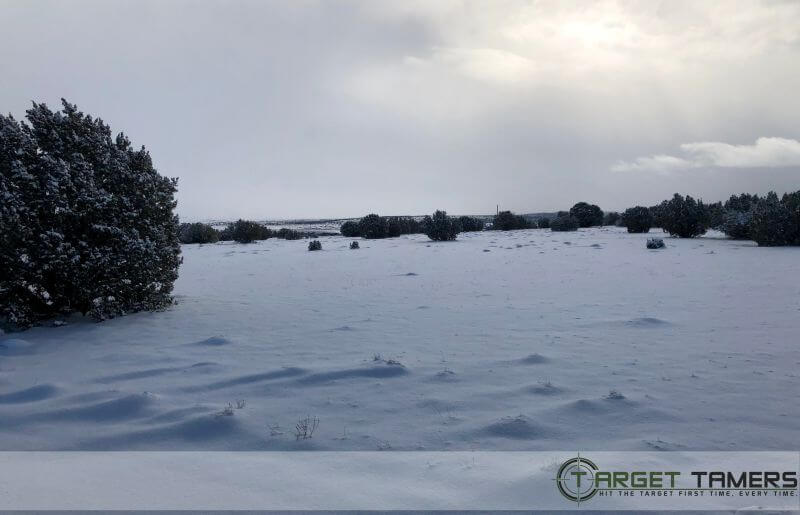
Does the Bushnell Prime range as far as it claims it does?
Remember, snow changes the ability to acquire readings on an object, and in this case, it proves very true for objects over 300 yards. However, the kind of big game hunting we do around here happens in the Fall and Winter, and we get some good snow coverage.
A lot of the time, the snow makes it easier to spot elk and deer since their brown fur stands out against the stark white backdrop. In that sense, I'm sure being able to range deer at Bushnell's claim of 350 yards is reasonable.
Unfortunately, there was nothing alive that wanted to give its position away on this field test day to test this number.
Ranging to trees proved to be a little difficult with snow all over the branches and at further distances. Bushnell's claim in ideal weather is 550 yards. My furthest reading I could get was 423 yards.
Ranging to highly reflective objects was a challenge only because a beautiful coat of snow layered everything. But, I was able to spot a truck at 1037 yards and a car at 608 yards.
Bushnell says the Prime can range out 1300 yards to highly reflective targets, and in ideal weather, it just might be able to pull that off. If you want to range a bit further then you should take a look at the Bushnell Prime 1700 rangefinder.
However, in this kind of weather, I was never able to reach a reading more than 1037 yards, not even on well-exposed and large objects.
Another issue I ran into was the large aiming reticle. At these long distances, the Prime did not provide a distance reading on any object that did not fill the aiming reticle.
In fact, it struggled with reflective objects at 150 yards if it was smaller than the aiming reticle. The beam divergence is no way near the best of what I know rangefinders are capable of, but in my opinion, it's enough for big game hunting up to 400 yards.
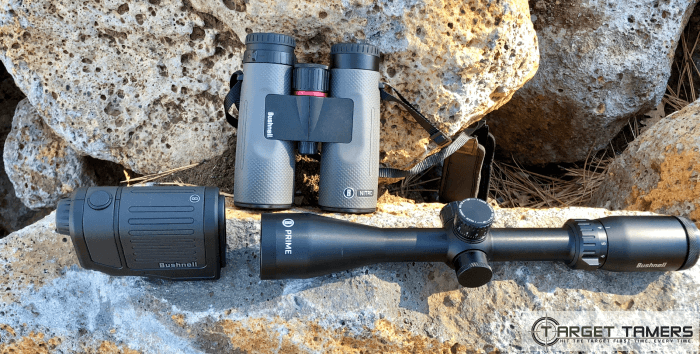
Accuracy
Is the Prime rangefinder accurate?
When you’re relying on accurate data to make a clean shot in the field, your rangefinder better be right. The Prime 1300 RF proved it’s an accurate range estimating tool out at the range and during field test days.
At the range, I was able to verify repeatable distances out to 100 yards since we have known distance markers set up. No issues, no gripe. On field test days, repeatable and consistent measurements were acquired when I was able to get a successful reading on the same object multiple times. It didn’t matter if it was 15 yards away or 1000, if the RF could locate it, you had an accurate distance reading on the display.
My Verdict on the Bushnell Prime 1300 Laser Rangefinder

If you wanted to use this rangefinder for hunting in the open fields where distances can quickly run up high, I wouldn't recommend it.
If you have other purposes in mind for a long-ranging rangefinder, you might find value in the Prime, but you'd want to use it in better weather than snow if you want to acquire any readings at all.
The Bushnell Prime range finder is a simple and easy to use optic. It is truly a one-button operation unit and is a rangefinder best suited for a hunter who takes down his trophy prey at less than 400 yards.
The built-in ARC mode allows for maximum functionality with every press of the button - thanks Bushnell, we'll never be an angle-ignorant hunter again.
All in all, the value of the Prime 1300 doesn't come from its ability to range out far, but instead it comes from its ease of use, auto ARC mode, and its high performance for close range distances. Using the Prime within its prime area of expertise is where it will perform at its best.
Further Reading



